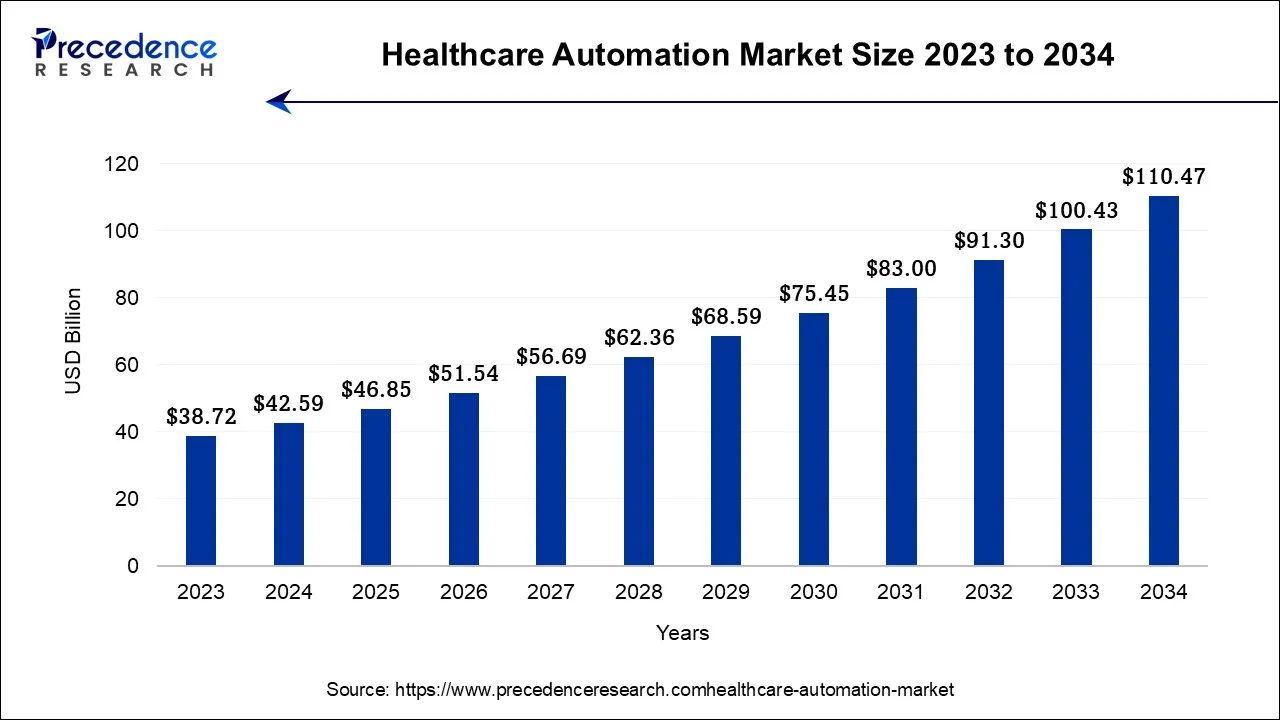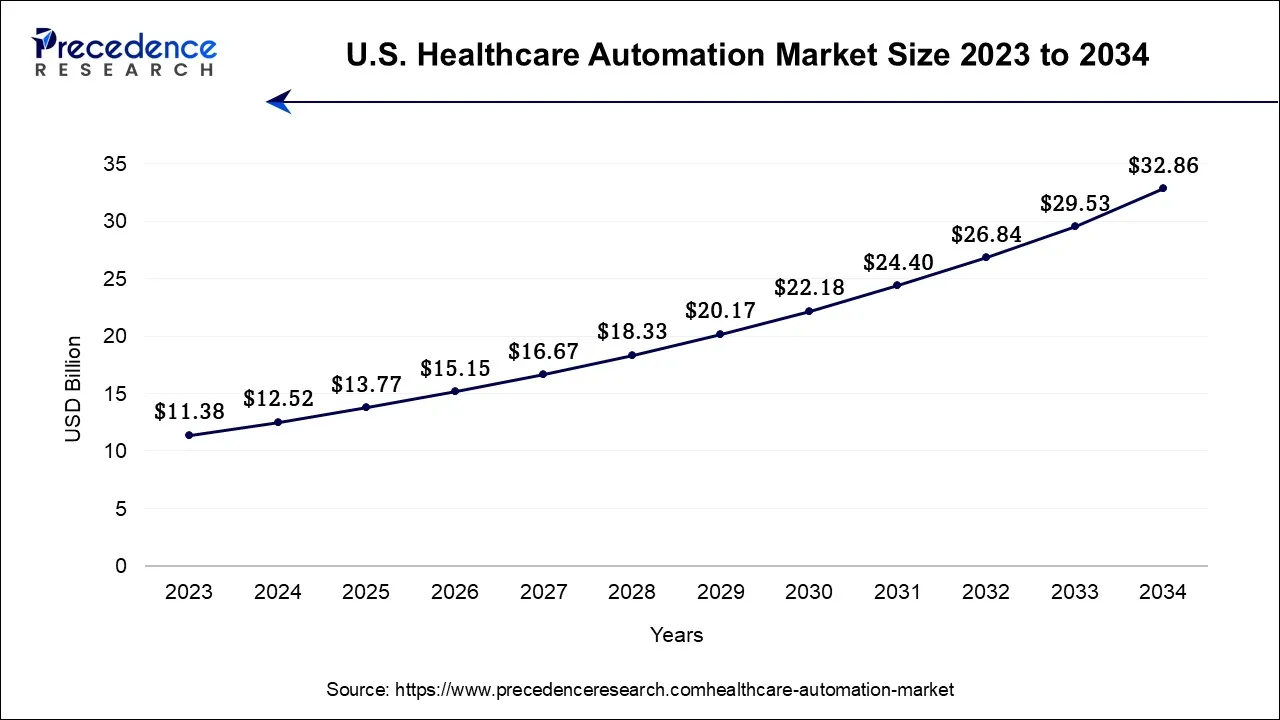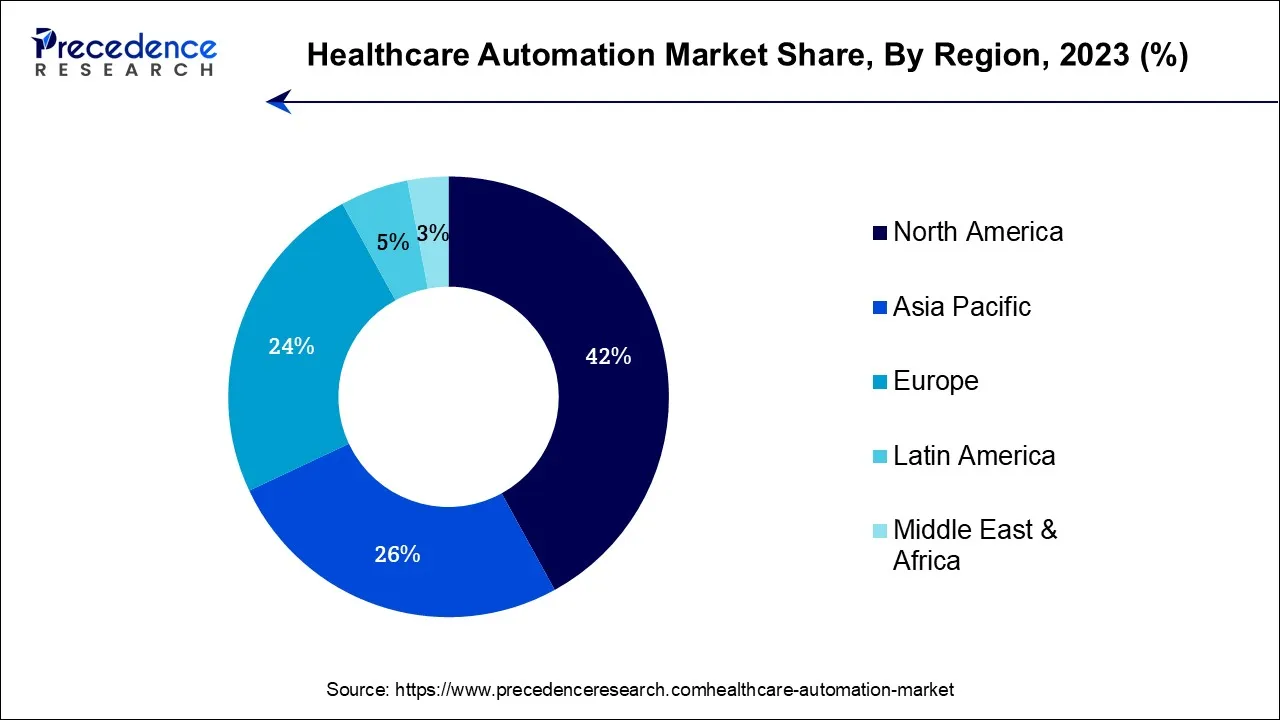List of Contents
Healthcare Automation Market Size and Forecast 2024 to 2034
The global healthcare automation market size is expected to be valued at USD 42.59 billion in 2024 and is anticipated to reach around USD 110.47 billion by 2034, expanding at a CAGR of 6.2% over the forecast period from 2024 to 2034. The rising telemedicine services, cost reduction, personalized treatment, and data management contribute to increasing demand for the healthcare automation market.

Healthcare Automation Market Key Takeaway
- North America dominated the market with a revenue share of around USD 42% in 2023.
- By application, the therapeutic automation segment accounted highest market share in 2023.
- By end-user, the research institutes & labs segment has contributed the highest market share in 2023.
U.S. Healthcare Automation Market Size and Growth 2024 to 2034
The U.S. healthcare automation market size accounted for USD 12.52 billion in 2024 and is projected to be worth around USD 32.86 billion by 2034, poised to grow at a CAGR of 6.35% from 2024 to 2034.

In the year 2023, North America is the dominating region in the healthcare automation market owing to the rising application of healthcare automation in the healthcare industry in this region. Moreover, the proliferation of increasing medical facilities, as well as rising government funding for technology advancement in the healthcare industry in this region, is driving the overall growth of the market in this region. A high number of in-progress clinical testing in countries like the U.S., and increasing demand for the application of technologically advanced healthcare devices in this region are also contributing to the growth of the healthcare automation market in the North American region. The U.S. Government organizations are investing in research and development to boost the healthcare automation sector innovation. Moreover, the high occurrence of both chronic and acute diseases and the increasing geriatric population is driving demand for the healthcare automation market.
North America is one of the leading regions in the healthcare automation market due to the increasing developments in healthcare and information technology. The increasing acceptance rate of high-techmedical devicesand healthcare reimbursement framework is driving the worldwide expansion of healthcare automation over the forecast period.

However, Asia-Pacific is expected to be one of the fastest-growing markets during the forecast years. Increasing government expenses on medical research, increasing clinical trials, growing geriatric population coupled with the rising prevalence of chronic diseases in this region, and improvement in medical infrastructure are some of the major factors that are expected to bolster the Asia-Pacific healthcare automation market growth in terms of value sales during the forecast period.
Market Overview
Healthcare automation refers to the process of utilizing robotic tools that are used in basic administration activities like revenue cycle management, claim processing, staffing, and reporting. Automation in healthcare refers to emerging technologies that enable organizations to improve efficiency and reduce potential errors.
Healthcare Automation Market Growth Factors
- Automation of tasks enables optimization of the operations, thus cutting health care expenses.
- The development of telemedicine services led to the need for the Integration of automated processes.
- AI, machine learning, and robotic advancement increase automation's feasibility and efficiency within a healthcare organization.
- Managing, analyzing, and even securing the patient data have become crucial, this brings potential components to the healthcare automation market to grow.
AI impact on the Healthcare Automation Market
AI automation introduced changes in healthcare and patient education in healthcare. AI automation has caused a positive change in efficiency, precision, and quality of patient care and management, introduced in hospitals, clinics, offices, and even pharmacies. AI automation enhances efficiency, accuracy, and patient results. AI is used in the healthcare field that diagnose diseases, identify cancer cells, analyze lab data, and medical data, and contribute to early diagnosis.
- In February 2024, Anatomy Financial unveiled AI-powered financial automation solutions for medical, dental, digital health, and healthcare billing companies.
Market Scope
| Report Coverage | Details |
| Market Size in 2024 | USD 42.59 Billion |
| Market Size by 2034 | USD 110.47 Billion |
| Growth Rate from 2024 to 2034 | CAGR of 6.2% |
| Largest Market | North America |
| Base Year | 2023 |
| Forecast Period | 2024 to 2034 |
| Segments Covered | Product, End-User, and Geography |
| Regions Covered | North America, Europe, Asia-Pacific, Latin America and Middle East & Africa |
Market Dynamics
Healthcare automation is a process of increasing accuracy and efficiency in medical activities with the help of wearable technologies, software, and robotics. The software robots take over repetitive tasks, detailed information, and processes and it makes the healthcare system feel better. For instance, Nanonets automation platform works for patient onboarding, survey processing, automating patient scheduling, form processing, and many more. Furthermore, in day-to-day work Healthcare automation increases healthcare delivery, from patient registration to treatment procedures in several sectors. As a result, automation supports the healthcare industry more significantly, which results in these factors driving the growth of the market. The benefits of automation in the healthcare sector boost the growth of the market due to the higher production rates, more effective use of raw materials, increase productivity and improve safety.
The global healthcare automation industry is predicted to grow at a significant rate during the forecast years. Various growth factors including continuous improvement in several healthcare automation technology, rising government investment on healthcare automation as well as increasing acceptance of healthcare automation system in pharmacy, medical logistics operations, laboratories, and others. The support of automation including information technology and the Use of control systems decreases individual effort in several procedures. Moreover, major prominent vendors invest in healthcare automation in order to enhance overall work efficiency and streamline various activities. This automation plays a vital role to lower their lab process cycle times, enhance the experimental data quality, and leveraging overall productivity in healthcare facilities.
Profound learning programs are offering medical professionals real-time intuition related to the medical history of the patients, blood tests, radiology images, genomics, and others. Thus, the aforementioned facts have driven the demand for healthcare automation systems in the medical industry which in turn is driving the growth of the global healthcare automation market in terms of revenue generation.
The rising innovative development such as advanced IT skills, entrepreneurs, basic digital skills, and adaptability is anticipated to fuel the growth of the global healthcare automation market during the forecast period. Furthermore, an increase in government support by providing funds and investments drives the growth of the market of automation in the healthcare industry. For instance, government bodies in Europe including Healthcare Products Regulatory Agency and Medicines are supporting automation systems for pharmacies.
Opportunity
Increasing Telemedicine Services
Telehealth solutions are rapidly being adopted, especially in the healthcare sector, automation, and control systems for healthcare are a significant market growth opportunity. Telemedicine services and healthcare automation can develop patient care and make healthcare more efficient. Telemedicine improves diagnostic accuracy, enables remote patient monitoring, analyzes medical images, and medical consulting services. The self-scheduling and AI facilitate appointments and patient queries boost the flow of telemedicine.
Product Insights
By product, the therapeutic automation segment accounted for the maximum share in the global healthcare automation industry. The rising prevalence incidences of several chronic diseases, as well as advancements in technology & medication system, is one of the integral factors which is contributing to the overall growth of the market in terms of value sales. However, the medical logistics & training segment is expected to rise at a significant growth rate during the forecast years. This is attributable to the rising acceptance of healthcare automation (AGV, pneumatic tubes, RFID, and RTLS) in hospitals as well as diagnostic centers all across the globe.
- In September 2024, Multiply Labs Announced a Collaboration on Automating Cell Therapy Manufacturing with Legend Biotech. Leveraging Multiply Labs' approach based on robo-chemical systems that can run virtually any equipment used in the cell and gene therapy market.
Additionally, the smart development application helps to treat patients carefully and manages ongoing care more effectively. Thus, these applications help patients to meet with attendants created in their proximity and actively coordinate pharmaceutical claims to the patient's needs, and after that schedule, the medical helpers visit the patient at home. Medical helpers provide the best possible care to patients with the help of access to their real-time patient data through a single interface.
End-User Insights
Depending on the end user, the healthcare automation market is divided into hospitals, research Institutes, home/Ambulatory Care, and diagnostic center. The research Institutes segment accounted for the maximum share in the global healthcare automation industry. The research Institutes are used for several reasons, such as accuracy, rising efficiency, reliability, quality, and timeliness of testing. This also gives helps to access test results that would otherwise be impossible to obtain and more difficult. This help to reduce the threat of human inaccuracy and offers an audit trail of test which results to confirm compliance requirements. Research institutes are investing to increase overall job productivity with lab digitization and program several processes. This automation is helping institutes such as lowering lab process cycle times, improving overall productivity and enhancing the quality of their experimental data.
Healthcare Automation Market Companies
- Siemens AG
- General Electric Company
- Swisslog Holding AG
- Koninklijke Philips N.V.
- Medtronic plc
- Intuitive Surgical, Inc.
- Stryker Corporation
- Danaher Corporation
- Accuray, Inc.
- Tecan Group Ltd.
Recent Developments
- In March 2024, Capsa Healthcare launched a new system that automates patients' prescription packaging. The automated packaging method, called NexPak, increases patient drug administration accuracy and efficiency.
- In June 2024, Keragon, an automation platform for the healthcare space, launched with $3M. The company aims to enable real-time synchronization of patient data across multiple systems and is the first no-code workflow automation platform in its field.
- In November 2023, LeadSquared announced a partnership with Reveal HealthTech, and revealed an Enhanced Automation Platform for Healthcare, which offers the best product solutions, delivery, and consulting services to the healthcare market.
- In Jan 2022, medical technology industry Becton, Dickinson, and Company declared acquisition with Parata systems for more than $1.5 billion. Parata systems offer automation products for pharmacies like inventory management software, high-speed robotic dispensers, workflow solutions, and adherence packaging tools. The Becton, Dickinson company's acquisition purpose is to operate pharmacies for people's healthier lives.
- In 2021, Siemens Healthineers AG acquired Varian Medical Systems, Inc. This is a German medical device company that allows the earlier to increase access to the latter's comprehensive portfolio as well as strengthen its position in the MedTech sector.
- In 2021, Philips acquisition with Capsule Technologies, Inc. They are providers of medical device integration and data technologies for hospitals and healthcare organizations. The purpose is to enlarge Philips's leadership in patient care management solutions. Capsule Technologies, Inc is providing medical device Information platforms such as device integration, clinical surveillance services, and vital signs monitoring. Philips's strategy is to transform the delivery of healthcare in the health field with integrated solutions. It helps to connect almost all medical devices as well as EMRs in hospitals.
- In 2021, IBM acquired mylnvenio to expand its automation portfolio with the latest acquisition. MyInvenio, is an Italy-founded process mining technology vendor. IBM provides IT and business process automation services to other organizations through automation groups such as Intelligent Document Processing, RPA, process orchestration capabilities, and Intelligent Virtual Agents. myInvenio acquired clients globally across the North American, UK regions, APAC, European, and others across key sectors like healthcare, pharmaceutical, banking, and financial services. This company help with data-driven process discovery, and monitoring to identify process improvement, analysis, and transformation opportunities.
- In 2020, One of the leading key players in the market ‘Health Catalyst, Inc. Acquired Healthfinch, In Electronic Medical Record c., a Wisconsin-based firm that provides a workflow integration engine that incorporates analytics & insights into Electronic Medical Record (EMR) workflows in order to enhance the efforts of medical experts to resolve the gaps of patient care on a real-time basis.
- In 2020, Medtronic plc acquired France-based Medicrea International. This medical device company is based in Dublin. The purpose of this acquisition is to enlarge its presence in the field of artificial intelligence, predictive analytics, and machine learning.
Segments Covered in The Report
By Product
- Therapeutic Automation
- Lab & Pharmacy Automation
- Medical Logistics & Training Automation
- Diagnostics & Monitoring Automation
By End-User
- Hospital
- Research Institutes
- Home/Ambulatory Care
- Diagnostic center
By Geography
- North America
- Europe
- Asia-Pacific
- Latin America
- Middle East & Africa (MEA)
For inquiries regarding discounts, bulk purchases, or customization requests, please contact us at sales@precedenceresearch.com
Frequently Asked Questions
Ask For Sample
No cookie-cutter, only authentic analysis – take the 1st step to become a Precedence Research client